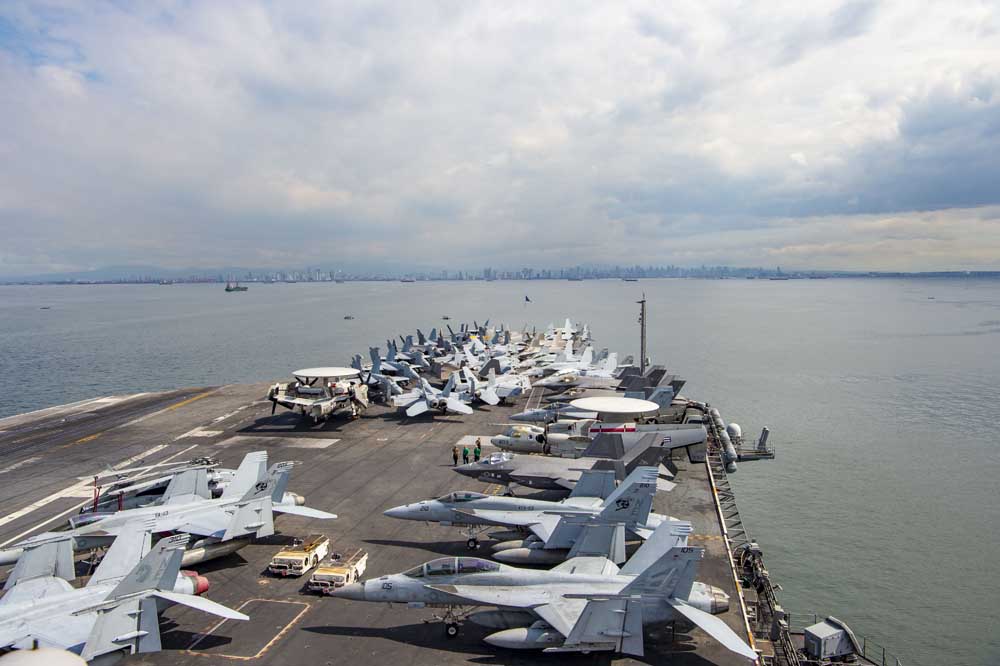Not for web
Published 9:00 pm Friday, January 5, 2024

- Nimitz-class aircraft carrier USS Carl Vinson sets anchors in Manila, Philippines.
On the last day of 2023, Navy helicopters took fire from — and then sank — three Houthi gunboats that attacked a private container ship in the Red Sea. The Navy had been contending for weeks with drones launched by Iranian-backed Houthis in Yemen, but this was the first time the rebels had fired directly on U.S. forces. Ten Houthis paid for that decision with their lives.
The actions, carried out to maintain a key channel of commerce, are a reminder of the global public goods the U.S. Navy provides, and why we need a strong one. Yet the Navy enters 2024 in rough seas: its struggle to build new ships, maintain existing ones — and recruit sailors — will take time and money to solve.
For too long, Washington has engaged in magical thinking about all of this. Concerned about China’s growing maritime presence, Congress has lately been authorizing the purchase of about 11 new warships every year, but the United States has the industrial capacity to build only a portion of those. Lawmakers, for example, typically order two submarines and three destroyers a year; but there are only enough skilled workers and materials to build and finish one of the former and two of the latter. On net, Congress isn’t increasing the Navy — the fleet, in fact, will shrink by a ship or two in 2028. It’s just padding the order books of a few big defense contractors.
There’s plenty of blame to go around: The Navy’s technical requirements for its ships are too complicated; the service remains allergic to smaller, unmanned alternatives; shipbuilding is more time-consuming than shipbuilders predict; and initial cost estimates come almost comically low. The price of several dozen Freedom-class littoral combat ships, for example, rose from $220 million to $500 million a copy until the Navy finally stopped building them. What the Navy (and many in Congress) once hoped would be stealthy, anti-submarine and countermine ships turned out to be gas-guzzling lemons that moved slowly and broke down fast. Many were decommissioned early; one, the USS Sioux City, was mothballed after only five years at sea.
And what’s the point of ordering more ships if the Navy cannot find sailors to crew them? While it easily exceeded its retention goals in 2023, the Navy finished its recruiting year 7,000 sailors short of its 37,700 target — a mark it reached only after raising the enlistment age to 41, and expanding waivers for tattoos and positive drug tests. “We are in a war for talent,” Adm. Lisa Franchetti, then the chief of naval operations, said in September.
One reason is a vibrant private job market; another is that instability in the Middle East and western Pacific has kept the fleet on a hectic operational tempo that means longer deployments away from family. USS Gerald R. Ford, America’s newest aircraft carrier, left Norfolk in May for what should’ve been a routine cruise; its tour has been extended three times. The Ford deployed several hundred sailors short of its normal complement of 2,548 enlisted personnel.
And when the carrier returns home for repairs, maintenance may not come quickly. At the Navy’s four public shipyards, most of the piers, dry-docks, cranes and machine shops are in poor shape or past their useful life; modernizing them will likely take 30 years and $25 billion.
Which means the ships we have often check in for overhauls but cannot check out. The guided missile cruiser USS Vicksburg has been undergoing repairs in Norfolk for more than six years. The USS Boise, an attack submarine, has been moored nearby for eight. The Navy’s shipyards, the GAO reports, will likely be unable to conduct nearly one-third of scheduled maintenance periods on aircraft carriers and submarines through 2040, a big dent on readiness.
Admirals and lawmakers should stop ordering more ships and focus on the less flashy but more important task of keeping the existing fleet as lethal as it can be. That means shifting funds from shipbuilding to modernizing our shipyards, taking emergency measures to recruit and train skilled workers and boosting incentives to serve on warships. Such steps would send a strong signal to China, and the world, how much this nation expects of its Navy now — and in coming years.








